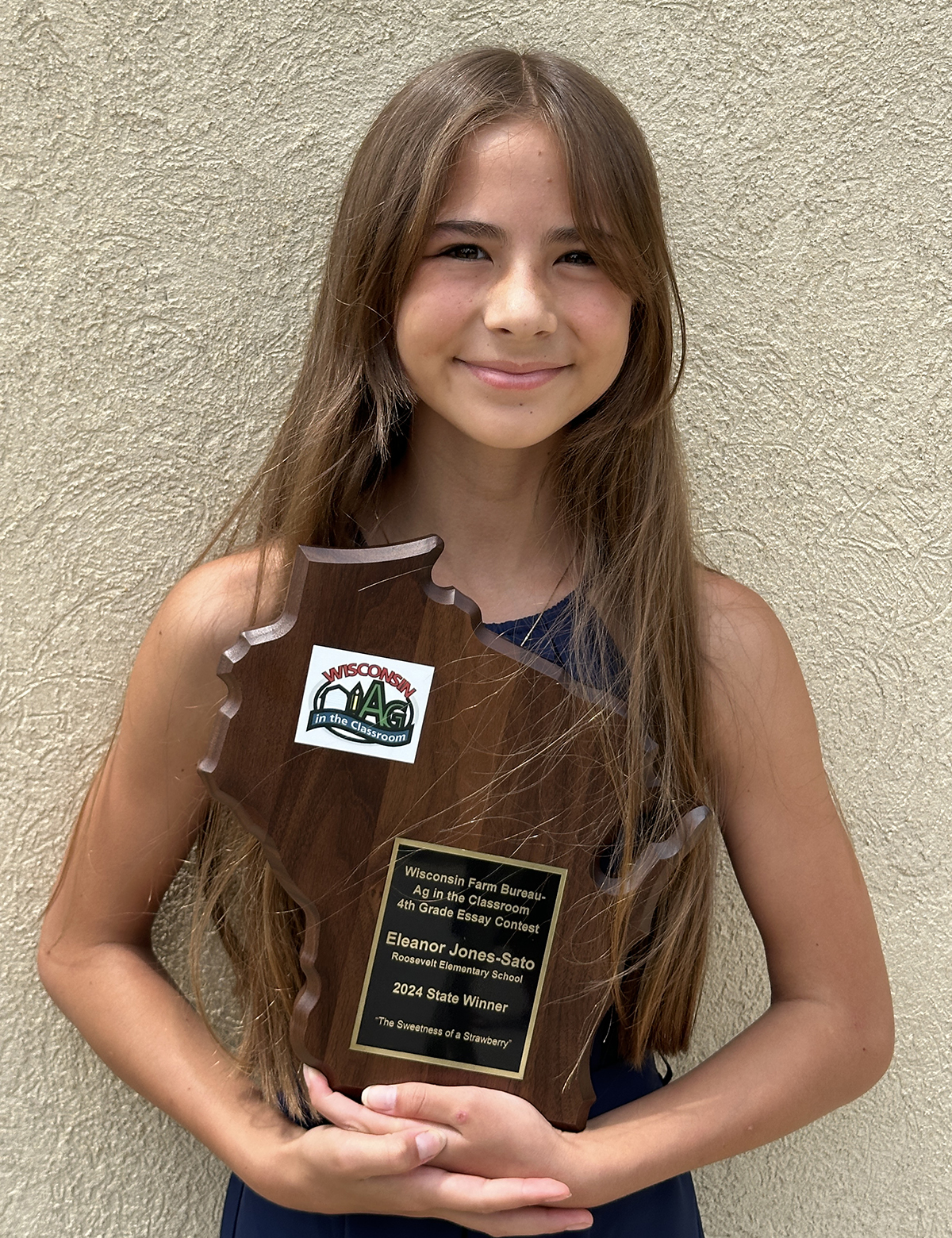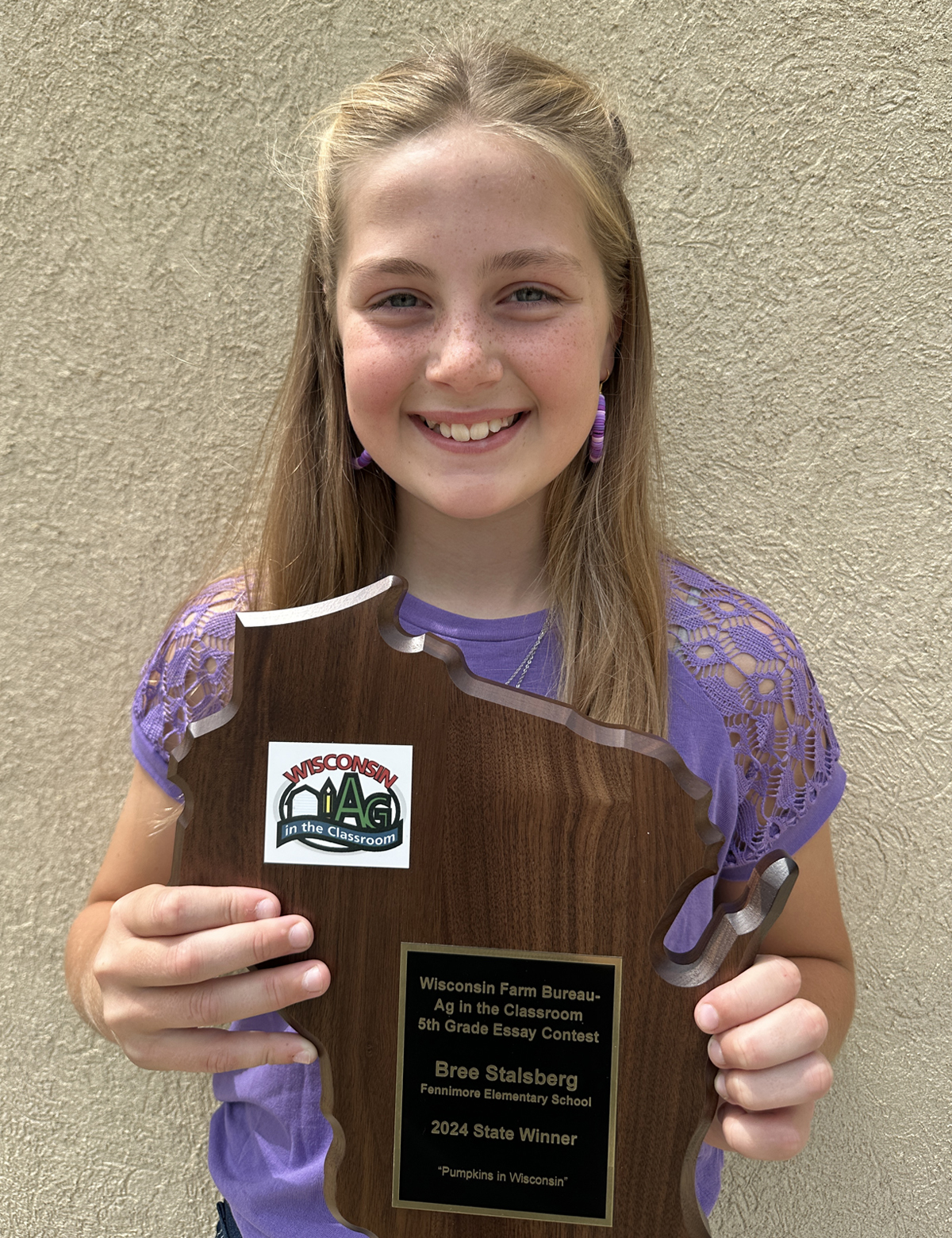Essay Contest
Essay Entries Due April 15, 2025
Teach Writing with Agriculture!

The Wisconsin Agriculture in the Classroom Essay Contest is an annual program that challenges 4th and 5th grade students to research and write an informative essay. The contest prompt explores Wisconsin history, geography, and economics through the lens of Wisconsin Agriculture and supports Wisconsin academic standards including English Language Arts, Social Studies, and Agriculture, Food and Natural Resources.
Learn how 4th grade teacher, Carmen D., teaches writing skills with the AITC Essay Contest
The essay contest gleans the annual theme from the 2024 American Farm Bureau Foundation for Agriculture Book of the Year, My Grandpa, My Tree and Me, by Roxanne Troup.
Wisconsin Agriculture is Tree-mendous!
Wisconsin is a top producer of food, fiber, and fuel that are grown, raised and produced from trees. Fruits, paper, maple syrup, Christmas Trees, nuts, timber, landscaping use, nuts, timber and more are all grown and produced from Wisconsin trees. The over 130 varieties of coniferous and deciduous trees have shaped Wisconsin’s history, communities and economy varieties of trees grown for agricultural uses.
Top essays are recognized at the district, and state levels. The generous support of sponsors and volunteers including the Wisconsin Farm Bureau Foundation, Compeer Financial and the Wisconsin Soybean Marketing Board, make this learning opportunity possible.
Read the 2024 Wisconsin Agriculture in the Classroom Winning Essays
Written by Eleanor Jones-Soto, Grade 4, Roosevelt Elementary, Janesville

"The Sweetness of a Strawberry"
Have you ever bitten into a sweet, ripe, juicy strawberry? I know I have. You can find strawberry farms and stores that sell strawberries all over Wisconsin, so I eat them all the time. There are over 600 different strawberries to choose from! Different places grow different strawberries, so you will always get different varieties to eat and enjoy.
This delicious fruit is planted much differently than you might think. The seeds of strawberries are very small. The seeds are actually in the inside of the ovaries (the “shell” of the seed). You would need a microscope to see the actual seed of a strawberry. Farmers get already sprouted strawberry plants shipped to them because it is so hard to plant the seed itself individually.
Strawberries are a very important part of our lives. They are very rich with vitamin C. Vitamin C helps with illnesses such as high blood pressure, common colds, cancer, asthma, and osteoarthritis. A lot of people sell and work with strawberries. There are 435,700 people who work in the strawberry industry today in Wisconsin! So if there weren't any strawberries, 435,700 people wouldn’t have jobs.
Strawberries are harvested by people, not machines. They are softer than other Wisconsin fruit such as apples or cherries. They are hand-picked. Lots of strawberry farms let people come and pick strawberries themselves. But if they were harvested by machines, they would get very soft and mushy. Strawberries that get shipped to stores are picked before they are fully ripe. This helps when they are being shipped so that they don’t get too soft. In the truck that they get shipped in, there are coolers to keep the strawberries as ripe as possible.
I love strawberries. The sweetness, the deliciousness, the amazing taste of a strawberry is more than my words can say. If you want to know what I’m trying to say, than go bite into a ripe strawberry!
Written by Bree Stalsberg, Grade 5, Fennimore Elementary School

"Pumpkins in Wisconsin"
Wisconsin grows and produces many fruits throughout the year, and one of my favorites is pumpkins. Have you ever visited a pumpkin patch and seen the bright green color turn to orange in the fall? Pumpkin patches are also big business for Wisconsin and Agrotourism. Whether you use them for decorating, eating, or carving, fall pumpkin patches can add income to local farms. Agrotourism is great for Wisconsin as it helps people get outside and connect to local farms and see where their food comes from. An acre of pumpkins can yield 15,000-30,000 pounds of pumpkins a year and Wisconsin grows about 3,500 acres annually.
Pumpkins have been around in Wisconsin for thousands of years. Pumpkins offer lots of nutritional value and vitamins such as vitamin A, B1, B6, and C. Pumpkins also offer copper, fiber, folate and manganese. They support and protect the heart. Early European explorers first brought pumpkins seeds back with them where they were used as a source of food for animals. Pumpkins quickly became a staple in the diets of settlers that arrived in America. People first started to cook the flesh of the pumpkin by roasting, baking, boiling, and drying it. Pumpkins are 92% water.
Pumpkins can be used as decorations for many homes. We put pumpkins on our steps outside and all around the driveway. Pumpkins are also used to make food such as pumpkin pie and pumpkin soup. Roasted pumpkin seeds are also a healthy snack. One of the most popular pumpkin traditions is carving jack-o-lanterns for Halloween.
Pumpkins are a big part of my life. Every year we plant pumpkins on our two-acre patch. Picking out pumpkin seeds for sizes, colors, and textures is a lot of fun. Pumpkins require lots of sunshine and space to grow. We plant the pumpkins in May when the soil temperature is about 70 degrees and harvest them in the fall. It takes about 100 days from the time seeds are planted until they turn orange and are ready for picking. As a family, we go out and pick the pumpkins onto a wagon, then wash the mud off.
Finally, we load them onto the wagon and take them into town where they can be sold on self-serve wagons. After all the picking is done and the season is about over, any extra pumpkins are used to have a pumpkin and Halloween party with all our friends and family. Growing pumpkins can be a challenge some years. With the lack of rain last year, we had to set up an irrigation system for our pumpkin patch. Pumpkins need about an inch of rain a week to grow.
I enjoy the process of seeing pumpkins grow from start to finish and know it takes a lot of work for a healthy and successful crop each year. Be sure to visit a pumpkin patch this fall for the perfect pumpkin!

